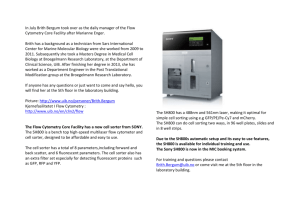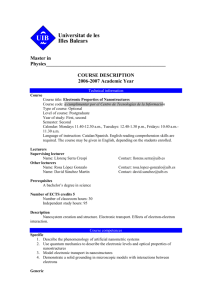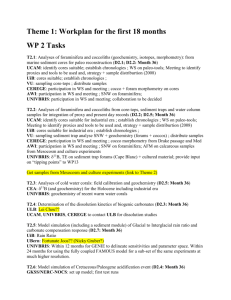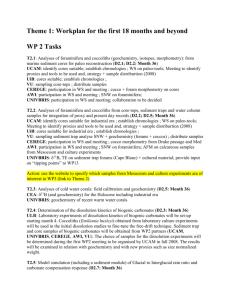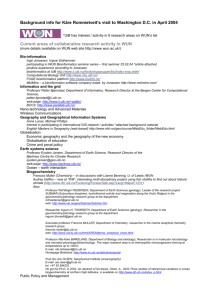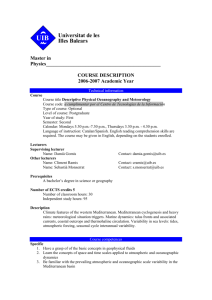Energy Consumption of the Mobile Wireless Sensor Network`s Node
advertisement
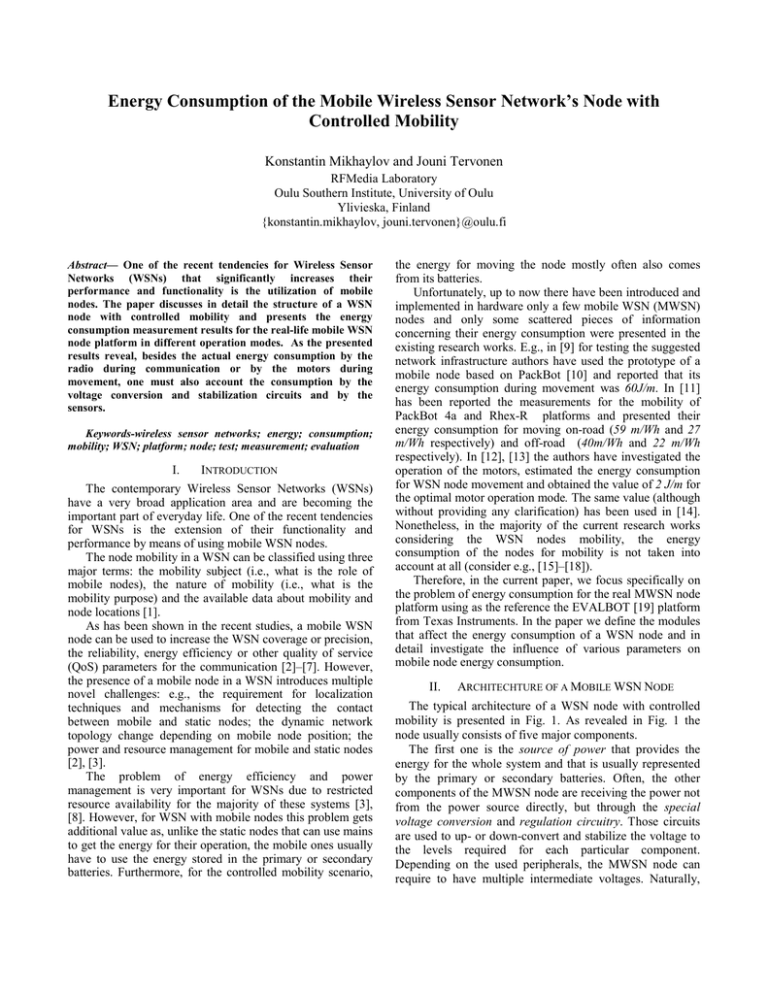
Energy Consumption of the Mobile Wireless Sensor Network’s Node with
Controlled Mobility
Konstantin Mikhaylov and Jouni Tervonen
RFMedia Laboratory
Oulu Southern Institute, University of Oulu
Ylivieska, Finland
{konstantin.mikhaylov, jouni.tervonen}@oulu.fi
Abstract— One of the recent tendencies for Wireless Sensor
Networks (WSNs) that significantly increases their
performance and functionality is the utilization of mobile
nodes. The paper discusses in detail the structure of a WSN
node with controlled mobility and presents the energy
consumption measurement results for the real-life mobile WSN
node platform in different operation modes. As the presented
results reveal, besides the actual energy consumption by the
radio during communication or by the motors during
movement, one must also account the consumption by the
voltage conversion and stabilization circuits and by the
sensors.
Keywords-wireless sensor networks; energy; consumption;
mobility; WSN; platform; node; test; measurement; evaluation
I.
INTRODUCTION
The contemporary Wireless Sensor Networks (WSNs)
have a very broad application area and are becoming the
important part of everyday life. One of the recent tendencies
for WSNs is the extension of their functionality and
performance by means of using mobile WSN nodes.
The node mobility in a WSN can be classified using three
major terms: the mobility subject (i.e., what is the role of
mobile nodes), the nature of mobility (i.e., what is the
mobility purpose) and the available data about mobility and
node locations [1].
As has been shown in the recent studies, a mobile WSN
node can be used to increase the WSN coverage or precision,
the reliability, energy efficiency or other quality of service
(QoS) parameters for the communication [2]–[7]. However,
the presence of a mobile node in a WSN introduces multiple
novel challenges: e.g., the requirement for localization
techniques and mechanisms for detecting the contact
between mobile and static nodes; the dynamic network
topology change depending on mobile node position; the
power and resource management for mobile and static nodes
[2], [3].
The problem of energy efficiency and power
management is very important for WSNs due to restricted
resource availability for the majority of these systems [3],
[8]. However, for WSN with mobile nodes this problem gets
additional value as, unlike the static nodes that can use mains
to get the energy for their operation, the mobile ones usually
have to use the energy stored in the primary or secondary
batteries. Furthermore, for the controlled mobility scenario,
the energy for moving the node mostly often also comes
from its batteries.
Unfortunately, up to now there have been introduced and
implemented in hardware only a few mobile WSN (MWSN)
nodes and only some scattered pieces of information
concerning their energy consumption were presented in the
existing research works. E.g., in [9] for testing the suggested
network infrastructure authors have used the prototype of a
mobile node based on PackBot [10] and reported that its
energy consumption during movement was 60J/m. In [11]
has been reported the measurements for the mobility of
PackBot 4a and Rhex-R platforms and presented their
energy consumption for moving on-road (59 m/Wh and 27
m/Wh respectively) and off-road (40m/Wh and 22 m/Wh
respectively). In [12], [13] the authors have investigated the
operation of the motors, estimated the energy consumption
for WSN node movement and obtained the value of 2 J/m for
the optimal motor operation mode. The same value (although
without providing any clarification) has been used in [14].
Nonetheless, in the majority of the current research works
considering the WSN nodes mobility, the energy
consumption of the nodes for mobility is not taken into
account at all (consider e.g., [15]–[18]).
Therefore, in the current paper, we focus specifically on
the problem of energy consumption for the real MWSN node
platform using as the reference the EVALBOT [19] platform
from Texas Instruments. In the paper we define the modules
that affect the energy consumption of a WSN node and in
detail investigate the influence of various parameters on
mobile node energy consumption.
II.
ARCHITECHTURE OF A MOBILE WSN NODE
The typical architecture of a WSN node with controlled
mobility is presented in Fig. 1. As revealed in Fig. 1 the
node usually consists of five major components.
The first one is the source of power that provides the
energy for the whole system and that is usually represented
by the primary or secondary batteries. Often, the other
components of the MWSN node are receiving the power not
from the power source directly, but through the special
voltage conversion and regulation circuitry. Those circuits
are used to up- or down-convert and stabilize the voltage to
the levels required for each particular component.
Depending on the used peripherals, the MWSN node can
require to have multiple intermediate voltages. Naturally,
Figure 1. Typical architecture of a MWSN node with controlled
mobility.
even if the peripheral connected to these voltage lines is not
currently used and stay in low-power mode, the voltage
conversion circuits themselves consume some energy
(consider, e.g. [20]).
The second component is the control unit that controls
the operation of the mobile WSN node and the required
peripherals, such as the read-only memory (ROM) for
program storage and random access memory (RAM) for
temporal data storage. In case if the WSN node is controlled
by a microcontroller, the external memory chips are usually
not required [20].
The third component of the MWSN node is the set of all
sensors, actuators and user interfaces. Besides the actual
sensors required by the application, the MWSN node
usually needs some additional ones for enabling its
mobility. In the most general case, those include the sensors
required for MWSN node localization and obstacle/collision
detection, navigation and movement control (e.g., speed
measurement).
The fourth component of the MWSN node is the chassis
and the motors to enable node movement. Depending on the
application, the MWSN node can require to move over air,
water or ground and the used chassis can differ
significantly. In the current paper, we will focus on the
scenario of movement over the ground as it is the most
common today. For the movement over the ground, three
major options for the chassis can be used: the wheels, the
caterpillars and the walking legs [13]. As reported in [13],
the wheels are often used for MWSN application due to
their low cost and easy manipulation. To transform the
electrical energy into the mechanical energy required for
wheel or caterpillar rotation or leg movement the MWSN
nodes use the motors. For enabling the movement direction
change, the node usually requires to have at least two
motors (for wheel or caterpillar chassis).
The final component of the MWSN node is the set of
communication interfaces (i.e., the set of wireless and/or
wired transceivers). Depending on the application and
Figure 2. TI EVALBOT with installed CC2430 radio module.
Figure 3. Block structure of TI EVALBOT + CC2430 MWSN node
used in the tests.
environment, the MWSN can use ultrasonic [21], optical
[22], [23], or radio communication. For the ground scenario,
the radio communication is usually chosen.
III.
TESTBED MOBILE WSN PLATFORM DESCRIPTION
For our tests we have used the EVALBOT [19] platform
from Texas Instruments (TI) presented in Figs. 2 and 3. The
EVALBOT is implemented as the circular printed circuit
board with 10cm diameter and with the installed 2.4 GHz
radio board has the height around 9.5 cm (up to the top of the
swivel antenna). The total weight of the platform with
TABLE I. CURRENT CONSUMPTION OF MOBILE WSN NODE PERIPHERALS
Supply
voltage,
V
5
5
5
5
5
5
5
5
5
5
5
5
5
5
5
5
5
5
5
5
5
5
5
5
5
Controller
clock,
MHz
-a
sleep
4
10
16
20
50
16
16
16
16
16
16
16
16
16
16
16
16
16
16
16
16
16
16
LED1
UIb
UIb
UIb
UIb
UIb
UIb
UIb
ON
ON
UIb
UIb
UIb
UIb
UIb
UIb
UIb
UIb
UIb
UIb
UIb
UIb
UIb
UIb
UIb
UIb
LED2
UIb
UIb
UIb
UIb
UIb
UIb
UIb
UIb
ON
UIb
UIb
UIb
UIb
UIb
UIb
UIb
UIb
UIb
UIb
UIb
UIb
UIb
UIb
UIb
UIb
OLED
display
UIb
UIb
UIb
UIb
UIb
UIb
UIb
UIb
UIb
Black
Half-white
White
UIb
UIb
UIb
UIb
UIb
UIb
UIb
UIb
UIb
UIb
UIb
UIb
UIb
Motor
left, rpm
UIb
UIb
UIb
UIb
UIb
UIb
UIb
UIb
UIb
UIb
UIb
UIb
0
10
50
99
UIb
99
UIb
UIb
UIb
UIb
UIb
UIb
UIb
Motor
right, rpm
UIb
UIb
UIb
UIb
UIb
UIb
UIb
UIb
UIb
UIb
UIb
UIb
UIb
UIb
UIb
UIb
-993
99
UIb
UIb
UIb
UIb
UIb
UIb
UIb
Wheel
sensor
left
UIb
UIb
UIb
UIb
UIb
UIb
UIb
UIb
UIb
UIb
UIb
UIb
UIb
UIb
UIb
UIb
UIb
UIb
on
UIb
UIb
UIb
UIb
UIb
UIb
Wheel
sensor
right
UIb
UIb
UIb
UIb
UIb
UIb
UIb
UIb
UIb
UIb
UIb
UIb
UIb
UIb
UIb
UIb
UIb
UIb
on
UIb
UIb
UIb
UIb
UIb
UIb
Radio
UIb
UIb
UIb
UIb
UIb
UIb
UIb
UIb
UIb
UIb
UIb
UIb
UIb
UIb
UIb
UIb
UIb
UIb
UIb
RX4
RX5
TX: 0.6dBm
TX: -0.4dBm
TX: -5.7dBm
TX: -25.2dBm
Current
consumption, mA
76.7
85.5
86.3
89.9
92
95.4
110
95
98.1
114
120
126
113
118
134
153
153
192
156
113.5
111.5
116.7
111.2
105.5
102
a. microcontroller and all peripherals are in reset mode
b. uninitialized
c. reverse rotation direction
d. no radio signal
e. strong radio signal (RSSI: -40 dBm)
installed radio module and three AA alkaline batteries is 189
g (without batteries – 118 g). The node is controlled by the
LM3S9B92 32-bit ARM® Cortex™ with the processor core
that supports clock frequency up to 80 MHz [24]. The
microcontroller has 256 kB single-cycle Flash and 96 kB
single-cycle Static RAM [24] on-chip. For the movement,
the EVALBOT is equipped with two 12V motors that are
controlled by the microcontroller through motor driver
circuits. The motors rotate two 2.4 cm diameter wheels. The
actual speed of the wheel rotation can be measured using 2
infra-red (IR) sensors installed near each wheel. Besides the
motors, the EVALBOT contains: several light-emitting
diodes (LEDs) and pushbuttons, 96x6 organic LED (OLED)
display, audio codec and speaker, MicroSD card connector,
RJ45 Ethernet connector and USB connectors. Also, the
board has several lines connected to microcontroller General
Purpose Input/Output (GPIO) pins that can be used for
connecting external peripherals and the connector for
connecting wireless boards from TI. For our tests, we have
attached to EVALBOT the CC2431 IEEE 802.15.4compatible radio boards from TI [25].
As revealed in Fig. 3, to meet the on-node peripherals
requirements, the voltage conversion circuits convert the
voltage obtained from the batteries into five different
constant voltages, namely: 1.8V; 3.3V; 5V; 10V and 12V.
IV.
MEASUREMENT METHODOLOGY AND RESULTS
To measure the current consumption for mobile WSN
node components we have used the test-bed presented in
Fig. 4. The embedded software that has been developed for
TABLE II. EFFECT OF SUPPLY VOLTAGE ON THE CURRENT
CONSUMPTION OF MOBILE WSN NODE WITH ACTIVE RADIO
(both radio and SoC microcontroller core are active)
Radio
mode
TXa
TXa
TXa
TXa
TXa
TXa
TXa
TXa
TXa
TXa
RXb
RX_PKTc
Value in
transmit
power
register
3
5
7
9
11
15
19
27
95
255
-
Radio
transmit
power,
dBm(mW)
-25.9
-19.7
-16.4
-13.2
-11.0
-8.1
-6.1
-2.9
-0.8
0.6
-
Current consumption,
mA
Vbat
Vbat
Vbat
4V
4.5V
5.5V
100.9 100.4 102.0
102.3 100.6 102.3
102.7 101.1 102.8
103.0 101.8 103.3
103.9 102.2 103.9
104.8 103.8 105.0
105.4 104.6 105.5
107.5 106.4 107.8
110.2 110.2 111.2
115.9 115.8 116.7
112.7 112.3 113.5
112.6 111.3 111.5
a. – radio transmit
b. – radio receive (no signal)
c. – radio receive (strong signal)
the MWSN node testing allowed to control each peripheral
device separately. The measurements for energy
consumption, as revealed in Fig. 4, were done using the
current-shunt method that is well proven for energy
consumption measurements for embedded systems and
WSN nodes [26]–[28]. The results revealing the current
consumption of the MWSN node peripherals are revealed in
Table I and Fig. 5. The maximum instrumentation error for
these results is below 1 mA. The first thing that can be
noticed from the presented data in Table I is that the MWSN
node had very high current consumption in reset mode when
no system on the node was actually functioning. We assume
that the majority of this consumption is caused by the
voltage conversion and stabilization circuits.
As revealed in Table I, to minimize the energy
consumption per computed instruction the microcontroller
on MWSAN node should run at high clock frequencies
(compare with [20]). The utilization of user interfaces on
MWSN, as can be seen from the presented data, increased
the consumption of the MWSN node by approximately 3mA
for each LED and by 19 to 31 mA for 96x6 OLED display.
For the latter one, the consumption depends on the number
of the segments that are used. The consumption by the
motors for the tested scenario (the measurements were done
with the robot running on a flat wooden surface) depends on
the wheels rotation speed almost linearly and was the same
for both motors and both directions. Also, as can be seen
from the presented data, the IR sensors, which measured the
actual wheel rotation speed and the passed way, consume
almost as much energy as both motors running with 60
revolutions per minute. The active radio module increased
the current consumption of the node by around 21 mA for
radio in the receive mode and by 10-25 mA for radio
transmission depending on used transmission power (see
Fig.6).
As can be seen from Fig. 5, although the MWSN node is
equipped with voltage regulation circuits, its current
consumption was changing depending on the supply
voltage. Besides, the trends to supply voltage effect on the
current consumption differ for various components. So, the
current consumed by the MWSN node components that
required voltage up-conversion (i.e., OLED display and
motors – see Fig. 3) decreased with the increase of the
voltage while for the other peripherals increase of supply
voltage increased the current consumption as well. As the
current consumption for the display and motors are affected
by the supply voltage change more significantly, the total
energy consumption for the MWSN with all peripherals
active decreased with the increase of the supply voltage (see
Fig.5).
As revealed in Table II the current consumption by the
CC2431 radio module used on MWSN is defined by the
working mode of the radio. With the radio in receive mode,
the current consumption of the MWSN node increased by
around 19-21 mA. Note, that the consumption by the radio
for the cases when there was no radio signal and when the
radio transmission was going on is slightly different. This is
caused by the Automatic Gain Control (AGC) system in the
radio. As can be seen in Fig. 6, the dependence of the
current consumed by the radio from the radiated radio signal
power is quite close to linear. Nonetheless, as revealed in
Fig. 6 and Table II, even with the minimum transmit power
sittings the radio consumes at least 10 mA. As reveal Table
II, the battery voltage level (Vbat) of the MWSN node was
not significantly influencing the consumed by the radio
current. Fig. 7 illustrates the typical operations sequence for
Figure 4. Experiment set-up used for measuring the consumption of
the mobile WSN node.
Figure 5. Effect of supply voltage on current consumption of the
MWSN platform.
Figure 6. Effect of radio module’s transmission power setting on
radiated radio signal power
radio packet transmission, the lengths and the current
consumption at different stages. As can be seen, to send the
Figure 7. Effect of radio module transmission power (see Fig. 6) on the current consumption of MWSN node at 5.5V power
supply (packet payload 55 bytes)
data via radio the MWSN node controller first of all
transmits the data to the radio (phase 1) using the wired
interface (in tested case radio and microcontroller of
MWSN node were connected over UART [28] interface
with 115200 bit/s data rate). After that, the microcontroller
core of CC2430 processes the received data (phase 2) and
activates the radio. After radio start-up and calibration
(phase 3), it switches to the receive mode to check the radio
channel (phase 4). Finding that the channel is free, the radio
recalibrates itself (phase 5) and finally sends the data (phase
6). Once the packet is transmitted, the radio is switched off.
V.
DISCUSSION AND CONCLUSIONS
The results presented in the paper reveal that the
consumption of the tested platform motors was around 2-3 J
per meter of the way depending on the supply voltage level.
This is quite close to the analytic results obtained and used
e.g., in [12-14]. Nonetheless, the results of the measurements
for real hardware reveal that besides the actual energy
consumption by the motors on MWSN node, one should also
consider the consumption by the other components. For the
tested platform, the current consumption by the voltage
conversion and stabilization circuits was in the order of 7080 mA, which is as much as the consumption by the motors
running at half speed. Besides, the tested platform, as well as
many other contemporary mobile platforms, has no means to
control or disable the voltage conversion circuits. This is
allowable in the case if the MWSN node moves all the time,
but if the mobility of the MWSN node is sporadic (which is
assumed for many suggested MWSN applications and
protocols – e.g., [29], [30]) this will significantly reduce the
lifetime of the mobile node. The presented in the paper
results reveal that with active radio and inactive motors,
around 66% of the total energy consumed by the MWSN
node is used by the voltage conversion circuitry. Besides, to
control the movement the MWSN node requires extra
sensors for measuring the speed of node movement and
passed distance. As revealed in the paper, the consumption
for those is also quite significant and is comparable to the
consumption of the motors. The consumption of the radio
module depends on the working mode of the radio. For the
tested module it ranged from 10 to 25 mA during radio
packet transmission and was around 21 mA during radio
reception.
The current paper is the first, to the best of our
knowledge, which focuses and in detail discusses the
structure and the energy consumption of the miniature
mobile WSN node platform with controlled mobility. We are
sure that the data presented in the paper are valuable both for
the WSN practitioners and for researchers. For the former
ones, the data presented in the paper provides valuable
information for MWSN nodes hardware design, possibilities
and features for such nodes. For the latter ones, the presented
data allows a better understanding about the behavior of the
MWSN nodes and allows improving the MWSN simulation
accuracy.
Although the presented in the paper measurements have
been executed only for the single MWSN node platform, we
are sure that the revealed in the paper general dependences
will be similar also for the other platforms. In the future we
will consider extending the measurements presented in the
paper by also testing other MWSN platforms to prove this.
Besides, we will continue the work with the described
MWSN platform and test its behavior in real-life MWSN
applications.
ACKNOWLEDGMENT
The authors wish to thank all parties who have financially
supported this study. This work has been supported by
European Regional Development Fund, Council of Oulu
Region, Ylivieska Subregion, Ylivieska Town, Kerttu
Saalasti Foundation, and NIHAK development organization.
The authors also wish to thank the reviewers for valuable
contributions and comments on the earlier version of this
article.
REFERENCES
[1]
[2]
[3]
[4]
[5]
[6]
[7]
[8]
[9]
[10]
[11]
[12]
[13]
[14]
[15]
K. Mikhaylov and J. Tervonen, “Data collection from isolated
clusters in wireless sensor networks using mobile ferries,” Proc. The
International Symposium on Frontiers of Information Systems and
Network Applications (FINA’13(WAINA’13)), in press, Mar. 2013.
M. Di Francesco, S. K. Das, and G. Anastasi, “Data collection in
wireless sensor networks with mobile elements: a survey,” ACM
Trans. Sen. Netw., vol. 8, no. 1, Aug. 2011, pp. 7:1–7:31,
doi:10.1145/1993042.1993049.
J. Rezazadeh, M. Moradi, and A. S. Ismail, “Mobile Wireless Sensor
Networks Overview,” Int. J. of Computer Communications and
Networks, vol. 2, no. 1, Feb. 2012, pp. 17 –22.
M. Marta and M. Cardei, “Using sink mobility to increase wireless
sensor networks lifetime,” Proc. International Symposium on a World
of Wireless, Mobile and Multimedia Networks (WOWMOM’08),
IEEE
Press,
Jun.
2008,
pp.
1–10,
doi:10.1109/WOWMOM.2008.4594857.
S. Sharma, M. Rani, and S. B. Goyal, “Energy efficient data
dissemination with ATIM window and dynamic sink in wireless
sensor networks,” Proc. International Conference on Advances in
Recent Technologies in Communication and Computing
(ARTCom’09), IEEE Press, Oct. 2009, pp. 559–564,
doi:10.1109/ARTCom.2009.9.
S. Tang et al., “DAWN: energy efficient data aggregation in WSN
with mobile sinks,” Proc. 18th International Workshop on Quality of
Service (IWQoS’10), IEEE Press, Jun. 2010, pp. 1–9,
doi:10.1109/IWQoS.2010.5542765.
B. Nazir and H. Hasbullah, “Mobile sink based routing protocol
(MSRP) for prolonging network lifetime in clustered wireless sensor
network,” Proc. International Conference on Computer Applications
& Industrial Electronics (ICCAIE’10), IEEE Press, Dec. 2010, pp.
624–629, doi:10.1109/ICCAIE.2010.5735010.
K. Mikhaylov and J. Tervonen, “Energy–efficient routing in wireless
sensor networks using power–source type identification,” Int. J. of
Space-Based and Situated Computing, vol. 2, no. 4, Oct. 2012, pp.
253–266, doi:10.1504/IJSSC.2012.050008.
A. A. Somasundara, A. Kansal, D. D. Jea, D. Estrin, and M. B.
Srivastava, “Controllably mobile infrastructure for low energy
embedded networks,” IEEE Trans. Mobile Computing, vol. 5, no. 8,
Aug. 2006, pp. 958–973, doi:10.1109/TMC.2006.109.
iRobot
Corporation,
“iRobot
510
PackBot,”
url:http://www.irobot.com/en/us/robots/defense/packbot/~/media/File
s/Robots/Defense/PackBot/iRobot-510-PackBot-Specs.ashx.
B. Mcbride, R. Longoria, and E. Krotkov, “Measurement and
prediction of the off-road mobility of small robotic ground vehicles,”
Proc. Performance Metrics for Intelligent Systems Workshop
(PerMIS’03), Sep. 2003, pp. 1–8.
F. El-Moukaddem, E. Torng, G. Xing, and S. Kulkarni, “Mobile
relay configuration in data-intensive wireless sensor networks,” Proc.
IEEE International Conference on Mobile Adhoc and Sensor Systems
(MASS’09),
IEEE
Press,
Oct.
2009,
pp.
80–89,
doi:10.1109/MOBHOC.2009.5336920.
G. Wang, M. J. Irwin, P. Berman, H. Fu, and T. La Porta,
“Optimizing sensor movement planning for energy efficiency,” Proc.
International Symposium on Low Power Electronics and Design
(ISLPED’05), IEEE Press, Aug. 2005, pp. 215–220,
doi:10.1109/LPE.2005.195517.
N. Shigei, I. Fukuyama, H. Miyajima, and Y. Yudo, “Battery aware
mobile relay for wireless sensor network,” Proc. International
MultiConference of Engineers and Computer Scientists, IAENG,
Mar. 2012, vol. 1, pp. 164–169.
W. Wang, V. Srinivasan, and K.-C. Chua, “Extending the lifetime of
wireless sensor networks through mobile relays,” IEEE/ACM
Transactions on Networking, vol. 16, no. 5, Oct. 2008, pp. 1108 –
1120, doi:10.1109/TNET.2007.906663.
[16] Y. Yun and Y. Xia, “Maximizing the lifetime of wireless sensor
networks with mobile sink in delay-tolerant applications,” IEEE
Transactions on Mobile Computing, vol. 9, no. 9, Sep. 2010, pp. 1308
–1318, doi:10.1109/TMC.2010.76.
[17] C. Chen, J. Ma, and K. Yu, “Designing energy-efficient wireless
sensor networks with mobile sinks,” Proc. The ACM Conference on
Embedded Networked Sensor Systems (Sensys’06), ACM, Oct. 2006,
pp. 1–9.
[18] W. Liang and J. Luo, “Network lifetime maximization in sensor
networks with multiple mobile sinks,” Proc. IEEE Conference on
Local Computer Networks (LCN’11), IEEE Press, Oct. 2011, pp.
350–357, doi:10.1109/LCN.2011.6115315.
[19] Texas Instruments, “Stellaris® LM3S9B92 Robotic Evaluation
Board,” url:http://www.ti.com/lit/ml/spmt213/spmt213.pdf.
[20] K. Mikhaylov, J. Tervonen, and D. Fadeev, “Development of energy
efficiency aware applications using commercial low power embedded
systems,” in Embedded systems - theory and design methodology, K.
Tanaka, Ed. Rijeka, Croatia: InTech, 2012, pp. 407–430.
[21] M.-K. Byeon, J.-H. Jeon, and S.-J. Park, “Point-to-multipoint
ultrasonic communication modem for ubiquitous underwater wireless
sensor networks,” Proc. IEEE/IFIP Internation Conference on
Embedded and Ubiquitous Computing (EUC’08), IEEE Press, 2008,
pp. 685–688, doi:10.1109/EUC.2008.180.
[22] D. Anguita, D. Brizzolara, and G. Parodi, “Building an underwater
wireless sensor network based on optical: communication: research
challenges and current results,” Proc. International Conference on
Sensor Technologies and Applications (SENSORCOMM’09), IEEE
Press,
Sep.
2009,
pp.
476–479,
doi:10.1109/SENSORCOMM.2009.79.
[23] J. Mathews, M. Barnes, and D. K. Arvind, “Low power free space
optical communication in wireless sensor networks,” Proc. Euromicro
Conference on Digital System Design, Architectures, Methods and
Tools
(DSD’09),
Aug.
2009,
pp.
849–856,
doi:10.1109/DSD.2009.234.
[24] Texas Instruments, “Stellaris® LM3S9B92 Microcontroller,”
url:http://www.ti.com/lit/ds/symlink/lm3s9b92.pdf.
[25] Texas Instruments, “A True System-on-Chip solution for 2.4 GHz
IEEE
802.15.4
/
ZigBee,”
url:http://www.ti.com/lit/ds/symlink/cc2430.pdf.
[26] Z. Nakutis, “Embedded systems power consumption measurement
methods overview,” MATAVIMAI, vol. 2, no. 44, 2009, pp. 29–35.
[27] K. Mikhaylov and J. Tervonen, “Optimization of microcontroller
hardware parameters for wireless sensor network node power
consumption and lifetime improvement,” Proc. International
Congress on Ultra Modern Telecommunications and Control Systems
(ICUMT’10), IEEE Press, Oct. 2010, pp. 1150–1156,
doi:10.1109/ICUMT.2010.5676525.
[28] K. Mikhaylov and J. Tervonen, “Evaluation of power efficiency for
digital serial interfaces of microcontrollers,” Proc. International
Conference on New Technologies, Mobility and Security
(NTMS’12),
IEEE
Press,
May
2012,
pp.
1–5,
doi:10.1109/NTMS.2012.6208716.
[29] W. Y. Poe and J. B. Schmitt, “Self-organized sink placement in
large-scale wireless sensor networks,” Proc. IEEE International
Symposium on Modeling, Analysis Simulation of Computer and
Telecommunication Systems (MASCOTS’09), IEEE Press, Sep.
2009, pp. 1–3, doi:10.1109/MASCOT.2009.5366741.
[30] F. El-Moukaddem, E. Torng, and G. Xing, “Maximizing network
topology lifetime using mobile node rotation,” in Wireless
Algorithms, Systems, and Applications, vol. 7405, X. Wang, R.
Zheng, T. Jing, and K. Xing, Eds. Berlin, Heidelberg: Springer Berlin
Heidelberg, 2012, pp. 154–165.

